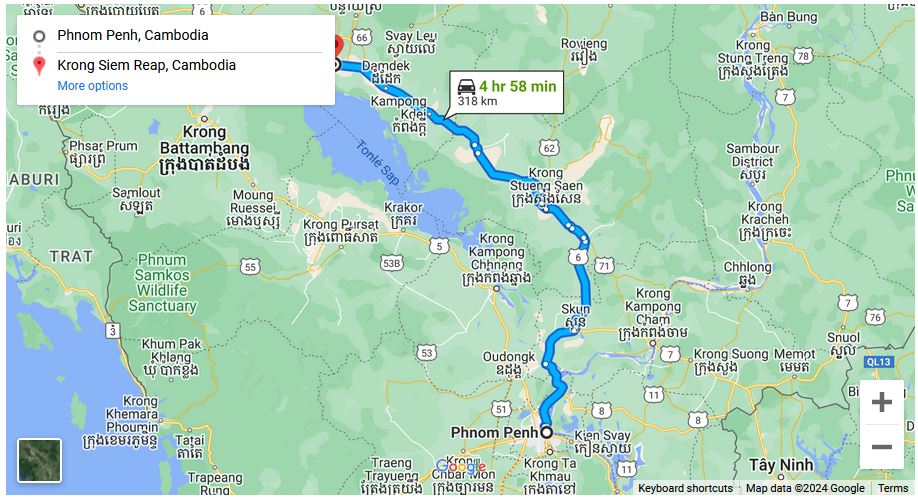The journey from Phnom Penh to Siem Reap is a captivating expedition through the heart of Cambodia, taking travelers from the bustling capital to the enchanting city that is home to the iconic Angkor Wat. As the landscape transforms from urban scenes to rural vistas, the road trip unveils the country’s cultural richness, historical wonders, and the serene beauty of the Cambodian countryside.
Leaving Phnom Penh behind, the journey heads northwest, traversing through the flat plains of the Cambodian countryside. The landscape is marked by rice fields, traditional villages, and the Mekong River, providing glimpses into the agricultural life that sustains much of Cambodia. The road journey allows travelers to witness the simplicity of rural living, with farmers tending to their fields and wooden stilt houses dotting the landscape.
En route to Siem Reap, the town of Skuon is often a curious pitstop for travelers. Known as “Spiderville,” Skuon gained notoriety for its roadside vendors selling fried spiders and other edible insects. For the adventurous, this presents an opportunity to sample local delicacies and experience the unique culinary offerings of Cambodia.
As the journey progresses, the town of Kampong Thom beckons with its historical significance and cultural attractions. The impressive Sambor Prei Kuk, a group of ancient temples dating back to the Chenla Empire, stands as a testament to Cambodia’s early history. The temples, adorned with intricate carvings and surrounded by lush greenery, provide a tranquil setting for exploration.
Continuing on the road, travelers eventually reach the bustling town of Siem Reap, the gateway to the magnificent Angkor Archaeological Park. Siem Reap is not just a base for exploring the temples; it is a vibrant city in its own right, offering a blend of traditional Khmer charm and modern amenities.
At the heart of Siem Reap is the renowned Pub Street, a lively area filled with restaurants, bars, and nightclubs. Pub Street is a hub of activity after sunset, attracting both locals and tourists looking to unwind and enjoy the city’s vibrant nightlife. Street performers, live music, and a diverse array of culinary offerings make Pub Street a central point for socializing and entertainment.
The main attraction drawing visitors to Siem Reap is undoubtedly the Angkor Archaeological Park, a UNESCO World Heritage site that houses the stunning Angkor Wat and numerous other temples. Angkor Wat, the largest religious monument in the world, is an architectural marvel with intricate carvings, towering spires, and reflective pools. Sunrise and sunset at Angkor Wat are particularly magical, creating a play of light and shadows on the ancient stone structures.
Beyond Angkor Wat, the park is dotted with temples such as Bayon, Ta Prohm, and Banteay Srei, each with its own unique charm and historical significance. Exploring the temples is a journey through time, with ancient ruins surrounded by lush vegetation and mystical atmospheres.
The Tonle Sap Lake, the largest freshwater lake in Southeast Asia, is another attraction near Siem Reap. Travelers can take boat trips to floating villages, witnessing the daily lives of the communities that inhabit the lake’s stilted houses.
Siem Reap’s cultural offerings extend beyond the temples, with museums like the Angkor National Museum providing insights into the history and artistry of the Khmer Empire. Traditional Apsara dance performances showcase Cambodia’s classical dance and storytelling traditions, offering visitors a glimpse into the country’s rich cultural heritage.
In conclusion, the journey from Phnom Penh to Siem Reap unfolds as a passage through Cambodia’s diverse landscapes and cultural treasures. From the rural simplicity of the countryside to the awe-inspiring temples of Angkor, travelers on this road trip experience the contrasts and richness that define Cambodia’s character. Siem Reap, with its blend of ancient wonders and modern vibrancy, serves as the perfect gateway to explore the historical and cultural depths of this Southeast Asian gem.



